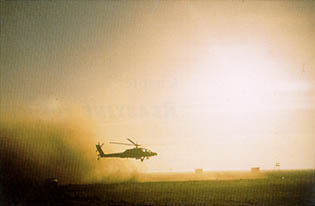
Apaches and the Air War. One of the Apache helicopters returns from striking a blow against Iraqi radar sites.
Further discussions finally led to a dramatic meeting in Geneva on 9 January between Baker and Aziz. After over six hours of talks, a somber Baker informed reporters that he saw no signs of Iraqi flexibility or intention to comply with the United Nations resolutions. Three days later both houses of Congress passed resolutions authorizing the president to use military action to enforce the United Nations demand for an Iraqi withdrawal from Kuwait. As neutral diplomats worked frantically to reach a last-minute settlement, all eyes turned toward the Gulf in grim expectation of the outbreak of war.
Hostilities were not long in coming. At 2300 local time on 16 January, the crews of nine Apaches and one Black Hawk of the 101st Airborne Division (Air Assault) boarded their helicopters after a final intelligence update. They joined a squadron of Air Force search-and-rescue helicopters and flew into western Iraq, using night vision goggles and infrared radar to navigate and keeping low to avoid detection. About 0200, 17 January, the Apaches locked on to their targets, two early warning intercept stations, and fired HELLFIRE missiles at them. Within minutes, the missiles knocked out every piece of radar equipment in the stations, crumbling buildings and vehicles. As the Apaches turned away from the destruction, the crews heard over one hundred Air Force jets overhead, passing through the gap in the radar bound for Baghdad. One hour later, television networks broke into their scheduled news broadcasts to report the bombing of the Iraqi capital. With well-synchronized destruction of early warning sites by raids and Navy-launched cruise missiles, the coalition air forces caught the Iraqis completely by surprise.1
154

Apaches and the Air War. One of the Apache helicopters returns from striking a blow against Iraqi radar sites.
For months, President Saddam Hussein, hoping to rally Arab support, had warned that he would attack Israel in the event of a conflict. He now moved to carry out his threat. Within twenty-four hours of the allied air attack, the Iraqis launched the first of seven Scuds at Israel, injuring twelve in the Tel Aviv area. By 25 January the Iraqis had fired twenty Scuds at Israel and twenty-four at allied bases and cities in Saudi Arabia. Israelis called for revenge, but their government, at the request of the United States, agreed to forego immediate retaliation.
The Scud attacks brought to center stage the Army's Patriot antimissile system. By the start of DESERT STORM Army Central Command had deployed about sixty Patriot systems to defend American military facilities, Saudi population centers, and industrial sites. Each battery consisted of a radar set, a computer-directed engagement control station, a power plant, antennae, and up to eight launchers, each with four ready-to-fire missiles in canisters. Originally designed as an antiaircraft device, the system had been modified by Raytheon, practically on the eve of the war, to shoot down missiles. Its antimissile capability had never been tested in combat and only rarely on the range.
Nevertheless, the system seemed to perform well in its first combat trial. The apparent success of the Patriot sent a wave of relief through the
155
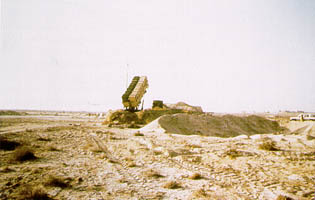
Patriot Launcher Near King Abdul Aziz Air Base. This launcher engaged the first Iraqi Scud fired during the war.
coalition and the international community, troubled by the prospect of chemical attacks by missiles targeted at defenseless cities. In response to an Israeli request, the United States, on 19 January, sent two batteries and their American crews to Israel to guard against further Scud attacks.2
Later evaluations showed that the Patriot, while it seemed to perform beyond expectations, was not infallible. As of early March 1991 the Army estimated that the Iraqis had fired eighty-six Scuds, eleven of which were aimed at Israel prior to the deployment of Patriots. Of the remaining seventy-five, forty-seven were considered threatening and Patriots engaged forty-five of them. Other studies gave different success rates, one estimating that Patriots destroyed 89 percent of the missiles aimed at Saudi Arabia and 44 percent of the Scuds targeted on Israel.
Occasionally, the Patriot did fail, largely because it was not designed to intercept the modified Scud, with its smaller warhead. Often, the Scud disintegrated in flight, and the Patriot went after the largest fragment, rather than the warhead. The missile which killed twenty-eight Pennsylvania reservists in their Dhahran barracks on 25 February seemed to have fallen into that category. Still, considering the relatively untested status of the Patriot system before the Persian Gulf operation, it performed well.3
Whatever the success rate, the Patriot took a major psychological weapon from the Iraqis in a war that, by any measure, was going badly for them. Thanks largely to the surprise achieved on the first night, U.S. and allied air forces quickly established dominance of the skies, destroying Iraqi planes on the ground and driving the rest into hiding or internment in Iran. Flying 2,000 sorties a day, coalition jets hit airstrips, command centers, air defense facilities, and nuclear and chemical plants. After the first week of DESERT STORM only five Iraqi air bases were still in operation, and allied jets had bombed 75 percent of Iraq's command cen-
156
ters. Having established air supremacy, the allies concentrated on the lines of communications of Iraqi forces in the Kuwaiti theater of operations. In three weeks they knocked out thirty-three of the thirty-six bridges along Iraqi supply lines and cut shipments of food, spare parts, and medical supplies to the Kuwaiti theater from 20,000 to 2,000 tons per week. By the fourth week the air phase of the offensive, intended to shape the battlefield for successful ground operations, entered its final stage, as the allies attacked troop concentrations and other targets in Kuwait. The air war went like clockwork, its only major digression being the effort to find and knock out the mobile Scud missile launchers.4
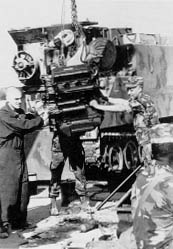
While the aviators continued to rain destruction on Iraqi forces, the
Army moved 270,000 troops with supplies into position for the attack. Through
December Maj. Gen. William G. Pagonis' newly redesignated 22d Support Command
had shifted supplies from the ports to depots near King Khalid Military
City, where engineers were building three enormous supply bases. With the
start of the air war on 16 January, the supply experts moved west of the
Wadi al Batin to set up a forward logistical base for each corps. The Army
Central Command sought to fill those bases with sixty days of supplies
by G-day, a formidable task given the shortage of heavy trucks and drivers,
the lack of railroads, and the heavy civilian traffic on the roads. For
five weeks supply vehicles rolled northwest on the main supply route DODGE,
or Tapline Road, the highway alongside the pipeline from the ports to Jordan.5
The massive westward shift of the XVIII Airborne Corps and VII
Corps to their attack positions began on 20 January, and the movement continued
unabated for about three weeks.6 Both corps traveled long distances,
over 500 miles for XVIII Corps and over 330 miles for VII Corps. The movement
of massive amounts of military equipment and supplies over the expanses
of the Arabian desert strained theater transportation units. To save tracked
combat vehicles from wear and tear, the 22d Support Command acquired almost
4,000 heavy trucks and distributed them to the corps in direct and general
support. Among those vehicles were about 1,300 heavy equipment transporters,
450 lowboys, and 2,200 flatbeds. General Pagonis took trucks from internal
U.S. military assets, European donations, loans that included an entire
Egyptian battalion of heavy equipment transporters, and commercial, locally
contracted sources. Many of the drivers were civilians from the Indian
subcontinent.7
157
U.S. FORCES IN THE PERSIAN GULF
| Date | Army | Total |
|---|---|---|
| 1 September1990 | 31,337 | 95,965 |
| 7 November 1990 | 124,704 | 266,096 |
| 15 January 1991 | 245,290 | 422,041 |
| 22 February 1991 | 296,965 | 533,608 |
Source: CENTCOM Daily Sitreps, Sep 90-Feb 91.
The Support Command's 318th Transportation Agency (Movement Control) coordinated the movement by allocating blocks of time for each corps to use designated main supply routes. The 89th Military Police Brigade provided checkpoint and traffic control on all lines.8 During the height of the movement, about eighteen vehicles per minute passed along any given stretch of road on the main supply route DODGE.9
During the last half of January the roads northwest of the ports were choked with vehicles taking the two corps to the front. Moving in the combat formation intended for the attack, most of VII Corps arrived at its designated assembly areas by 3 February. The 2d Armored Cavalry held an advanced position west of the Wadi al Batin at forward assembly area RICHARDSON, while the 1st Infantry Division (Mechanized), 1st Armored Division, British 1st Armored Division, elements of the 3d Armored Division, and the 11th Aviation Brigade stayed at tactical assembly areas astride the Tapline Road east of Wadi al Batin.
158
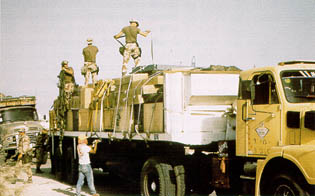
Securing Supplies on a Flatbed for movement forward
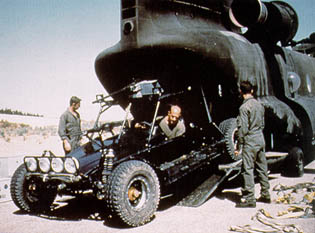
Unloading the Versatile Chinook Helicopter. The Special Forces used the pictured fast assault vehicle for reconnaissance behind enemy lines.
Meanwhile, XVIII Airborne Corps began its 500-mile deployment to Rafha by air and truck along the Tapline Road and a more southern route. Essentially, the entire corps had to leapfrog around the newly deployed Vll Corps to reach its destination on the left flank of the CENTCOM line, where its mobility would be a key asset in the flanking movement. When the great shift west was completed in the third week of February, XVIII Corps occupied the western portion of the Army line and Vll Corps the eastern. The XVIII Corps presented a front of three divisions and one separate regiment, with another division just behind the line. From left to right (west to east) stood the French 6th Light Armored Division, the 101st Airborne Division, the 24th Infantry Division (Mechanized), and the 3d Armored Cavalry. The 82d Airborne Division held a position behind the French. The VII Corps presented a front of five divisions and one separate regiment. From left to right stood the 1st and 3d Armored Divisions, the 1st Infantry Division, the British 1st Armored Division, and the 1st Cavalry Division (Armored). The 2d Armored Cavalry screened the boundary with XVIII Corps on the left.10
If an Iraqi pilot had managed to penetrate the air space over the border area during the great shift west, he would have been stunned by the panorama below. It was "mile after mile of tank transporters, gasoline tankers, troop and ammunition carriers," while "overhead was the continuous clatter of C-130 transport planes and cargo helicopters." Occasionally, a truck pulled into one of the rest stops along the twelve- to fourteen-hour ride from the ports to the assembly areas. If any proof of allied air supremacy were necessary, this was it: "I shudder to think," an American observer wrote, "what a couple of Iraqi planes could have done
159
to that column on a strafing and bombing run." Fortunately, Saddam Hussein had been, as the phrase went, "de-aired." Nor did the terrain prove too soft to support the vehicles, a concern of ARCENT planners in the early stages. Indeed, drivers found the ground along the road firmer than the coastal sands.11
Bases CHARLIE and ECHO each measured about 3 by 5 miles. CHARLIE supported the XVIII Airborne Corps and ECHO the VII Corps during the ground offensive. Each contained enough food, fuel, and ammunition to supply its designated corps. Before the ground offensive the two corps support commands drew their supplies directly from these bases. Once the land war started, the theater support command transported these commodities forward to trailer transfer points, where the respective corps took over responsibility.
The theater stockage in food, fuel, and ammunition was critical to the success of the ground offensive. Stock levels were expressed as "days of supply." General Pagonis set the theater stockage goal at sixty days by the start of the ground offensive, although he anticipated probable shortages in each of the commodity areas.13 By G-day, which was on 24 February, the available supply levels were nearly 29 days in food, 5.2 in fuel, and 45 days of ammunition.14
Fuel reserves gave the most cause for concern. POL (petroleum, oil, lubricants) arrived in the depots every day, but was consumed in vast quantities. To expedite the movement of these products forward, General Pagonis ordered the building of a pipeline from Ad Dammam to Al Batin. The project was only partially completed by 28 February, when offensive operations were halted. At that point Pagonis, a lieutenant general as of 7 February, canceled the pipeline. Meanwhile, the 475th Quartermaster Group used 1,200 civilian POL trucks to haul the fuel forward from the ports as quickly as possible. However, because of the swift closure of operations and lower-than-expected consumption levels, fuel did not become a major problem at the theater level. At the end of February 22d Support Command records indicated 5.6 days of supply on hand, an overall increase.15
160
General Pagonis also worried about food and ammunition supplies. Like fuel, however, the 22d Support Command maintained adequate quantities throughout DESERT STORM. When the shooting stopped, theater supplies of food were sufficient for twenty-five days and of ammunition for sixty-six days. Ammunition stores rose because of lower than expected expenditures and the arrival of several ammunition ships during the war.
In addition to managing the thousands of heavy trucks, the 7th and 32d Groups employed over 2,000 civilian drivers. The civilian drivers and commercial vehicles were organized into battalions with cadres of American soldiers, such as the 1103d Transportation Battalion of the 32d Group and the 702d Transportation Battalion (Provisional) of the 7th Group.17 Concern over the reliability of civilian drivers once offensive operations commenced prompted the 22d Support Command to acquire over 3,000 U. S. soldiers as backup drivers. During DESERT STORM daily absentee rates of civilian drivers fluctuated between 10 and 55 percent.18 By the end of the war, as the Iraqi threat decreased, attendance improved. Nevertheless, soldiers stood by to fill vacancies when civilians failed to report for work.
Heavy equipment transportation assets were the single most critical type of equipment in support of DESERT STORM. Just one of the five heavy divisions, the 24th Division, needed 1,277 heavy vehicles, 323 heavy equipment transporters, 445 lowboys, and 509 flatbeds-to move its heavy equipment from its forward assembly area to its attack positions.19
Approximately 1,000 Support Command cargo trucks also moved supplies for the two corps throughout DESERT STORM. But the number of military trucks on hand to haul supplies and heavy equipment simultaneously was never enough. The Army's heavy transporter units could move only about one-fourth of the total U.S. tanks at any one time.20
161
Contracting and host nation support provided much of the solution to the transportation problem. Over half of the heavy transportation assets were either contracted commercial trucks or donated trucks from Europe. The 32d Transportation Group commander, Col. Michael T. Gaw, credited the Saudis with providing enough commercial trucks to keep the Army moving on schedule.21 The operations officer of the 7th Transportation Group, Maj. Richard S. Gula, agreed. "If it were not for the Saudi HETs [heavy equipment transporters] and lowboys," he observed, "we could have never moved XVIII Airborne Corps."22
America's allies donated additional transportation assets. Such programs as the so-called Gifts of Japan contributed almost 2,000 fourwheel-drive sport utility vehicles, water trucks, refrigerator vans, and fuel vehicles.23 The small commercial four-wheel-drive trucks enhanced the flexibility and command and control capability of many units. It was commonplace in Saudi Arabia to see commanders traveling in brightly painted Japanese sport utility vehicles.
Donated and contracted commercial vehicles helped the theater logistical organizations make up for the lack of assigned military vehicles. Although fully equipped with authorized assets, many still lacked the mobility to meet the great demand for transportation in Saudi Arabia. Virtually every logistical unit commander faced a shortage of organic military transportation. All of the area support groups, which were major subordinate elements of the 22d Support Command that sustained units in specific geographic areas from fixed locations, reported they were only about 25-percent mobile. Those groups were not expected to be fully self-mobile because of the limited scope of their missions, but the long distances and frequent moves involved in DESERT STORM continually forced them to seek more vehicles.
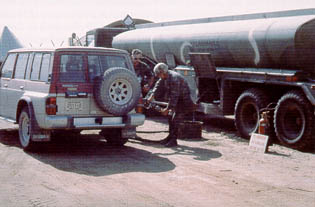
162
With engineer assistance, the 800th built two large POW compounds BROOKLYN and BRONX in the north along the main supply route DODGE. Completed in early February, each could hold about 28,000 prisoners of war at any one time. The brigade had intended to process Iraqi prisoners in accordance with the Geneva Conventions and eventually turn them over to Saudi authorities for final disposition. However, shortly after the start of the air war, POW operations took on their own dynamic because prisoners began to accumulate before the facilities were fully manned or finished. The Support Command diverted resources to ensure more rapid completion of the camps. The first Iraqi prisoners were received on 21 January; by G-day, a little over a month later, their number totaled 518.24
In contrast to Vll Corps, XVIII Airborne Corps had enjoyed plenty of time to prepare. Except for combined training with the French 6th Light Armored Division in close air support and recognition of each other's equipment, most of the corps' training near Rafh, a consisted of rehearsals, sand table exercises, and measures to sustain existing skills. Farther south, at King Khalid Military City, the 22d Support Command was equipping squads and crews from Army units outside the theater and training them to serve as replacements for the coming offensive.25
At the border, fighting had already started. The 1st Cavalry Division and the 2d Armored Cavalry patrolled the area west of the Wadi al Batin to screen the VII Corps' buildup from enemy reconnaissance scouts. The flat, open plain gave little concealment except for the wadies, in which an
163
unwary Bradley fighting vehicle could be surprised in the dark. To the north, cavalry patrols could see flashes and hear rumbling along the border as the Air Force pounded Iraqi positions. Occasionally, they picked up Iraqi deserters or destroyed enemy observation posts. More frequently with time, they clashed with Iraqi scouts seeking to penetrate the screen and learn the meaning of the activity to the south.
On 22 January, in XVIII Corps' sector near the boundary with VII Corps, the 3d Armored Cavalry took part in the first ground encounter of the campaign. A squad exchanged fire with an Iraqi force of undetermined size, possibly from the border police. Two Iraqis were killed and six captured at the cost of two American wounded. On the extreme left, patrols of the French 6th Light Armored, the 82d Airborne, and the 101st Airborne Divisions screened XVIII Corps' front near Rafha, manning listening posts and driving vehicles into the barren wastes. They encountered fewer Iraqi scouts this far west, but similar clashes nevertheless occurred.26
To discover what lay behind the border berms to the north, Central Command relied partly on Army special operations forces. During the early days of the crisis troops of the 5th Special Forces Group (Airborne), 1st Special Forces, in cooperation with Saudi paratroopers, had manned observation posts and driven vehicles along the Kuwaiti border to provide early warning of an Iraqi attack. Since September, almost the entire 5th Group had become involved in liaison work and combined training, and Central Command obtained a battalion of the 3d Special Forces Group (Airborne), 1st Special Forces, to carry out long-range patrols north of the border. The risky nature of the task guaranteed that each mission was reviewed carefully at the highest levels, and, in the end, the Green Berets carried out twelve such operations. Many of the missions failed because of poor prior intelligence, as in the case of a team that landed in the middle of an Iraqi armored division, but some performed valuable work. One team used low-light cameras and soil-probing equipment to determine if the terrain north of the border would support the heavy vehicles of VII Corps, while others watched suspected Iraqi reinforcement routes and hunted Scud launchers.
Psychological operations (PSYOPS) also made a major contribution. Radio and TV broadcasts, leaflets, and loudspeakers used the themes of Arab brotherhood, allied air power, and Iraqi isolation to induce large numbers of enemy soldiers to desert. One of the most effective tactics involved the dropping of leaflets on a particular unit, informing it that it would be bombed within twenty-four hours and had to surrender to avoid destruction. In other special operations, Army helicopters cooperated with those of the Air Force to rescue downed pilots, and civil affairs officers worked closely with the Kuwaiti government in its reconstruction planning. Although DESERT STORM proved to be primarily a campaign of mass units, special operations played an important part in the final victory.27
164
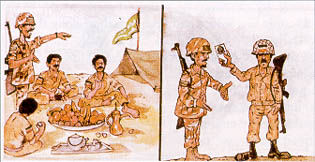
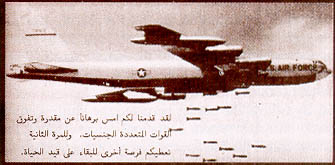
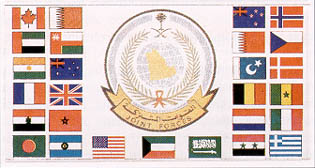
PSYOPS leaflets, showing the prevalent themes of Arab brotherhood (top), coalition air superiority (middle), and Iraqi isolation (bottom).
While not a special operations unit, the 4th Squadron, 17th Cavalry, carved its own niche during the opening weeks of DESERT STORM. The Army had originally formed the unit to help the Navy monitor American-flagged tankers in the Persian Gulf during the Iran-lraq war. It had returned to the region to help enforce United Nations sanctions before DESERT STORM. With the outbreak of war, the squadron patrolled, watched for Iraqi vessels, and raided offshore oil platforms used by the Iraqis to observe allied ship and plane movements. Technically part of the 18th Aviation Brigade, the unit operated from U.S. Navy frigates and received its missions from the Navy. On 18 January squadron helicopters from the frigate USS Mcholas cooperated with a Kuwaiti patrol boat to subdue Iraqi detachments on nine oil platforms in the northern Persian Gulf, capturing twenty-three prisoners in the process. The nine platforms represented the first Kuwaiti territory to be liberated in the war.28
To the west, as the air war entered its fifth week, VII Corps in battle formation moved to jump-off areas near the Iraqi border. The 1st Cavalry Division had already shifted to the corps' right flank to cover the Wadi al Batin. Once the last units of the 3d Armored Division filed into tactical assembly area HENRY on 11 February, VII Corps sped up preparations for the drive north. On the fifteenth the 1st Infantry Division and 2d Armored Cavalry moved to forward positions north of logistical base ECHO just short of the border, and the 1st Armored Division began its long march to forward assembly area GARCIA, on the left of VII Corps. The next day the 3d Armored Division drove to forward assembly area BUTTS, in the center and behind the 1st Infantry Division, while the British 1st Armored Division took position on the right at forward assembly area RAY and the 11th Aviation Brigade deployed to logistical base ECHO. By 17 February VII Corps had assembled over 1,500 tanks, 1,500 armored fighting vehicles, and 650 artillery pieces at the border.29
During the next week the VII and XVIII Airborne Corps completed their preparations while stepping up artillery bombardments and patrols. Because of the great range of the Iraqi artillery and its deployment 7 to 12 miles behind the border, allied gunners initially confined themselves to "shoot and scoot" artillery raids, penetrating well within the Iraqi
165
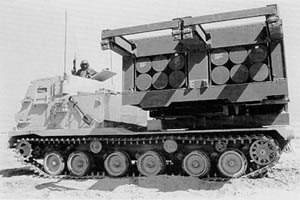
The Multiple Launch Rocket System
range to unleash a few salvos and changing their position. When it became clear that the Iraqis could not find them, allied batteries stayed in position and even closed the range to deliver a killing fire against enemy forward positions. Gunners from the 1st Infantry, the 1st Cavalry, and the British 1st Armored Divisions hit command posts, artillery emplacements, air defense facilities, and supply depots. Rockets from the multiple launch rocket system, dubbed "steel rain" by the Iraqis, shattered materiel and morale. One Iraqi division lost 97 of its 100 guns to a bombardment by 300 rocket pods and two battalions of 203-mm. howitzers. The Iraqi response to this fire was negligible. At times, allied gunners even tried to bait Iraqi artillery to pinpoint positions for counterbattery fire.30
As allied artillery and air power systematically eliminated the Iraqi artillery threat, allied cross-border patrols were winning the battle for noman's-land. On VII Corps' front, long-range surveillance units with the 2d Armored Cavalry observed Iraqi dispositions and fortifications. Using holes cut by engineers in the border berm, other patrols ventured into Iraqi territory to reconnoiter positions, to set ambushes, to capture prisoners, and to call in air and artillery fire against tanks, armored personnel carriers, command posts, and radar stations.
On the left flank XVIII Airborne Corps conducted mounted and aerial raids deep into Iraqi territory to hit armor, artillery, bunkers, and observation posts. In one armed reconnaissance mission by the Aviation Brigade of the 101st Airborne Division on 20 February, a helicopter with a loudspeaker induced 476 frightened Iraqis to surrender after fifteen of their bunkers were destroyed by air and TOW missile fire. The cross-border operations were not without cost, but Iraqi resistance was generally so weak that by the twenty-second helicopters of the 82d Airborne Division were penetrating deep into enemy territory in broad daylight.31
166
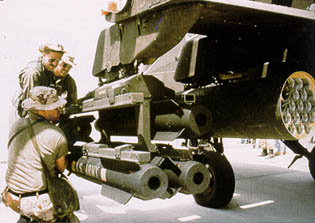
Loading HELLFIRE Missiles on an Apache Helicopter
With so many allied patrols into disputed areas fratricide was inevitable. Eight marines were killed by friendly fire in the first week of February. Then, on the seventeenth, two soldiers of the 2d Armored Division were killed and six wounded when a HELLFIRE missile, launched by an Apache to suppress Iraqi fire, crashed into their Bradley. The mixing of friend and foe in the enemy's rear, characteristic of American battle doctrine, as well as the deadliness of modern weapons beyond the range of easy identification, had created a situation in which friendly fire could be expected without proper countermeasures. To correct the situation, VII Corps experimented with glint and thermal tape, strobe and chemical lights, illuminated paint, and panels in an attempt to find a material that could easily identify a friendly vehicle at night without giving its position away to the enemy. Considering the number of friendly units in disputed areas, the number of incidents remained remarkably low, but the problem clearly would demand attention in the future.32
However menacing allied air power occasionally could be to friendly troops, it inflicted infinitely more punishment on the Iraqis. By G-day, intelligence indicated that the Iraqis had lost 53 percent of their artillery and 42 percent of their tanks in ARCENT's sector. Air attacks had reduced frontline units to less than 50 percent and reserves to 50 to 75 percent of their strength. Nearly 1,000 Iraqis, hungry and tired of the incessant bombing, had already given up to American troops. Unknown to the coalition at the time, thousands more apparently had deserted north. When an Iraqi reconnaissance in force to R'as al Khafji in late January was repulsed by Arab and Marine forces, American commanders interpreted the foray as a desperate Iraqi attempt to boost morale.
167
American generals had other reasons to be optimistic. Intelligence indicated that the Iraqis did not have many troops or defenses west of the triborder area. Although Iraqi strength in the Kuwaiti theater had risen from twenty-seven to forty-three divisions since November, most of the new troops had joined the forces inside Kuwait. Only seven weak Iraqi infantry divisions, backed by an armored division, manned improvised works on Vll Corps' front, while three widely dispersed infantry divisions faced XVIII Corps.33
After DESERT STORM General Schwarzkopf and some of his officers criticized the quality of the intelligence they had received. The coalition, they believed, had greatly overestimated enemy strength and capabilities. In retrospect, the intelligence effort reflected strengths and weaknesses that had long characterized Western information-gathering and analysis. Eavesdropping devices, satellite photography, and reconnaissance aircraft, frequently using new technology, produced high-quality raw data on Iraqi movements and positions. On the other hand, the number of agencies involved resulted in duplication of effort, and security compartmentalization prevented timely dissemination of information to the field. Commanders complained that they received reconnaissance photographs that were at least one day old and that estimates were often too vague to be meaningful. For all the aerial reconnaissance, Army Central Command apparently was never able to piece together an accurate picture of the defenses west of the triborder area, perhaps because the secrecy surrounding the flanking move had left responsible agencies unaware of the need. Finally, as in past crises, the lack of agents on the ground left American leaders in the dark regarding Iraqi intentions.34
168-169
Map 12 Jump Off Locations 23 February 1991
170
The high stakes contributed to friction between the Air Force and the Army over targeting. Although the two components had developed their plans separately, the respective planners had coordinated with each other during the process. Still, the Army believed that it lacked enough influence on the air plan's Phase III, the destruction of Iraqi units and defenses in Kuwait. Matters came to a head in early February, when the corps commanders and some on the ARCENT staff bitterly complained that the Air Force was not hitting the targets they had chosen. In part, the friction arose from misunderstandings, but the rigid planning cycle contributed to the problem. ARCENT's targets, drawn from the two corps and based on intelligence already several hours old, would not make the Air Force's daily list of targets until a day after they were submitted. Too often, the targets had moved by the time the bombers arrived. In the end, lower levels worked out their own arrangements, as Air Force wings talked directly with ARCENT headquarters and bypassed the cumbersome targeting process.35
Accurate bomb damage assessment would prove critical to the setting of the date for the ground offensive. On 27 January Lt. Col. Joseph H. Purvis' special planning cell, which had returned to Central Command, received orders to gauge the progress of the air war and project a date for the start of the ground campaign. Given the controversy surrounding the assessments and their preparation, the task proved difficult. Pentagon and Central Intelligence Agency analysts estimated the attrition of Iraqi forces at lower levels than Central Command, which put greater credence in the more optimistic reports of pilots. On 9 February CENTCOM and ARCENT planners reported that they were planning on fourteen more days to "shape the battlefield," but they did not specify a date to open the ground offensive. Another two weeks passed, as staffs kept a close watch over bomb damage assessments. On the twenty-first Army Central Command notified its commanders to be ready to move at any time. Later that day, Gday and H-hour were set for 24 February, at 3:00 AM Saudi time.36
171
Kuwait by noon, 23 February, or face the consequences. The ultimatum came amid unmistakable signs that the Iraqis were setting fire to oil wells and otherwise inflicting as much damage as possible on Kuwait. When noon, 23 February, passed without an Iraqi response to the president's message, a ground war seemed inevitable.37
Tariq Aziz was still in Moscow when the Iraqis responded to the increasing tempo of CENTCOM attacks by igniting 145 oil wells throughout Kuwait. Their action, apparently intended to hide their defensive positions in Kuwait and southern Iraq from allied aerial observation, came too late to matter. In the end, the act became a liability to Iraqi field operations in ensuing days and to Iraq's longer term interests as well.38
From R'as al Khafji to Rafha American troops braced for what the experts predicted would be a bloody confrontation. In Riyadh the ARCENT commander, Lt. Gen. John J. Yeosock, who had just returned from surgery in Germany, outlined his vision of the coming battle. The 1st Cavalry Division, back in theater reserve, prepared for its feint up the Wadi al Batin. To the left a patrol of the 1st Infantry Division engaged twenty Iraqi tanks, knocking out fourteen. Two squadrons of the 2d Armored Cavalry penetrated almost 10 miles into Iraq to protect engineers cutting a passage through the border berm. As day passed into evening on 23 February, XVIII Corps put long-range surveillance detachments into enemy territory. In a battalion of the 24th Infantry Division a sergeant major reminded his men, "The only way home is through Iraq." Rumors had already spread among the troops that 500 fillers were waiting to take the places of those who were killed and wounded. As the main forces waited, artillery bombardments and helicopter raids continued along the line.39 At 0100 on the morning of 24 February, the word came from Central Command: "EXECUTE ORDER FOR GROUND OFFENSIVE OPERATIONS (PHASE IV)."40
Notes
1 William H. McMichael, "First Shots Fired in Anger," Soldiers 46 (April 1991): 21-24; CENTCOM Sitrep, 17 Jan 91; William Matthews, "Thunder and Lightning of Desert Storm," Army Times, 28 Jan 91, p. 12.
2 MS, Doughty, War in the Persian Gulf, p. 8; "Weekly Briefing," Army Times, 4 Feb 91, p. 40; Matthews, "Thunder and Lightning of Desert Storm," p. 12; J. Paul Scicchitano, "Patriot: New Kind of War Hero," Army Times, 4 Feb 91, p. 34, Holley interview; Anthony H. Cordesman, "Rushing to judgment on the Gulf War," Armed Forces Journal international (June 1991): 72; Heike Hasenauer, "Theater Missile Defense: Improved Patriot," Soldiers 46 (June 1991): 25; Interv, Maj Robert B Honec and S Sgt LoDona S. Kirkland with Maj Stephen B. Finch, Air Defense Element, XVIII Airborne Corps, 2 Feb 91, XVIII Airborne Main Command Post, Rafha, Saudi Arabia; Steve Vogel and Julie Bird, "First Combat Patriot Hit Scores Big," Army Times, 28 Jan 91, p. 28A; William H. McMichael, "Patriot Passes the Combat Test," Soldiers 46 (April 1991): 18, Donna Miles, "Desert Storm Rises," Soldiers 46 (March 1991): 6-11.
3 Department of the Army, Classification of SWA Army Weapons Systems Performance, 8 Mar 91; MS, Doughty, War in the Persian Gulf, p. 8; Draft MS, Swain, Operational Narrative, p. 86; Cordesman, "Rushing to Judgment on the Gulf War," p. 72, Finch interview.
4 Matthews, "Thunder and Lightning of Desert Storm," pp. 12, 14; Miles, "Desert Storm Rises," pp. 6-11; William Matthews, "The Best Is Yet to Come," Army Times, 11 Feb 91, pp. 3-4; Matthews, "Assessing the Damage," Army Times, 18 Feb 91, p. 3; CENTCOM Sitreps, Jan-Feb 91; Vuono interview.
5 Draft MS, Swain, Operational Narrative, pp. 60-61, CENTCOM Daily Sitreps, Sep 90-Feb 91.
6 Msg, Cdr, ARCENT, to Cdr, ARCENT SupCom, 15 Jan 91, sub: Corps Movement.
7 22d SupCom, DESERT STORM Command Rpt, 5 Apr 91, p. 3.
8 ibid.
9 Pagonis Briefing to Secretary of the Army Stone, Apr 91, Dhahran.
10 Ibid.
11 Quotes from David H. Hackworth, "Light Near the End of the Tunnel," Newsweek (4 February 1991): 35.
12 Pagonis Briefing to Secretary of the Army Stone, Apr 91, Dhahran.
13 Theater Logistics Concept Briefing Charts for Secretary of Defense Cheney, 27 Dec 90.
14 22d SupCom Daily "sit down" Briefing Charts, 24 Feb 91.
15 Ibid., 28 Feb 91.
16 Interv, Maj Glen R. Hawkins with Col Daniel G. Brown, 15 Jan 91, Dhahran.
17 32d Transportation Group Command Rpt, 28 Feb 91; Interv, Maj William W. Epley with Maj Richard S. Gula, 20 Mar 91, Dhahran.
18 22d SupCom Daily "sit down" Briefing Charts, 29 Jan 91.
19 32d Transportation Group Command Rpt, 28 Feb 91.
20 Interv, Lt Col Wesley V. Manning and Maj Glen R. Hawkins with Col David A. Whaley, 13 Feb 91, King Khalid Military City, Saudi Arabia.
21 32d Transportation Group Command Rpt, 28 Feb 91.
22 Gula interview.
23 22d SupCom, DESERT STORM Command Rpt, 5 Apr 91, tab J, sub: Japanese (GOJ) and German Contributions.
24 22d SupCom, DESERT STORM Command Rpt, 5 Apr 91.
25 ARCENT, VII Corps, and XVIII Airborne Corps Sitreps, 16 Jan-15 Feb 91; Swain interview, Exercises and Training Section interview; Draft MS, Carver, How VII Corps Won the War, passim; ARCENT Exercises and Training Section Command Rpts.
26 ARCENT, VII Corps, and XVIII Airborne Corps Sitreps, 16 Jan-15 Feb 91, Steve Vogel, "Border Defined by Bomb Flashes," Army Times, 25 Feb 91, p. 6; "Cavalry, Patrol Exchange Gunfire in First Ground Encounter," Army Times, 4 Feb 91, p. 16; Vogel, "Stand Ready: lst Cavalry Division Scouts the Border for Iraqi Movements," Army Times, 25 Feb 91, p. 4; William H. McMichael, "Looking for Clues," Soldiers 46 (April 1991): 25-27.
27 General H. Norman Schwarzkopf, Briefing to the Press, 27 Feb 91 (hereafter cited as Schwarzkopf briefing); CENTCOM Sitreps; Draft MS, Stewart, Army Special Operations Forces in Operation DESERT STORM, pp. 1-11.
28 Phil Prater, "Night Moves in the Gulf," Soldiers 46 (May 1991): 14; Interv, Mal Robert K. Wright with Lt Col Bruce Simpson, 13 Feb 91, Manama, Bahrain; Miles, "Desert Storm Rises," p. 10.
ARCENT and VII Corps Sitreps, 11-15 Feb 91; Draft MS, Swain, Operational Narrative, p. 94; Draft MS, Carver, How VII Corps Won the War, passim.
30 ARCENT and VII Corps Sitreps , 15-23 Feb 91, "Steel Rain' Shut Down Iraqi Artillery," Armed Forces Joumal Intemational (May 1991): 37.
31 ARCENT, VII Corps, and XVIII Airborne Corps Sitreps, 15-23 Feb 9 1; William Matthews, "Final Round, "Army Times, 4 Mar 91, p. 6; Interv, Maj Dennis P. Levin with Maj Gen James H. Johnson, Jr., 20 May 91, Fort Bragg, N.C.
32 "Weekly Briefing," Army Times, 18 Feb 91, p. 10; Margaret Roth, "Officer Relieved After Fire Kills Two," Army Times, 4 Mar 91, p. 12; ARCENT Sitreps, 10, 18, and 22 Feb 91; Memo for DESERT STORM Study Group.
33 ARCENT Sitreps, 16 Jan-24 Feb 91, ODCSINT, Iraq-Kuwait Situation Updates, Dec 90-24 Feb 91; VII Corps and XVIII Airborne Corps Sitreps, 16 Jan-23 Feb 9 1; Draft MS, Swain, Operational Narrative, pp. 64, 8 7, 9 7; Holley interview; Julie Bird and Steve Vogel, "First Contact: Battle of Khafji," Army Times, 11 Feb 91, p. 12, Schwarzkopf briefing, MS, Doughty, War in the Persian Gulf, p. 11.
New York Times, 13 Jun 91; William Matthews, "U.S. Intelligence Not Geared to Read an Enemy's Motive," Army Times, 27 May 91, p. 18; Exercises and Training Section interview; Holley interview; Draft MS, Swain, Operational Narrative, pp. 82-84.
35 Holley interview; Holloway interview; CENTCOM Planning Cell interview, pp. 20-27; Draft MS, Swain, Operational Narrative, pp. 68-70; Interv, Col Richard M. Swain with Lt Col Bart J. Engram, ARCENT G-3, Deep Operations, 27 Mar 91.
36 Special Planning Cell chronology, pp. 18-19; Vines interview; Draft MS, Swain, Operational Narrative, pp. 92, 95; Holloway interview; Holley interview.
37 Margaret Roth and Sean D. Naylor, "This Is the Culminating Point of the Battle," Army Times, 4 Mar 91, p. 4; Matthews, "Final Round," pp. 3, 6.
38 ODCSINT Intelligence Summary 400, 23 Feb 91; Yergin, The Prize, pp. 180-81.
39 "Tanks and Men: Desert Storm from the Hatches," Army 41 (June 1991): 30; Michael Donnelly, "Groping Through G-Day in a Dust Storm," Army Times, 15 Apr 91, p. 16, ARCENT and XVIII Airborne Corps Sitreps, 23-24 Feb 91.
40 Draft MS, Swain, Operational Narrative, pp. 96-98.
page updated 7 June 2001
Return to the Table of Contents